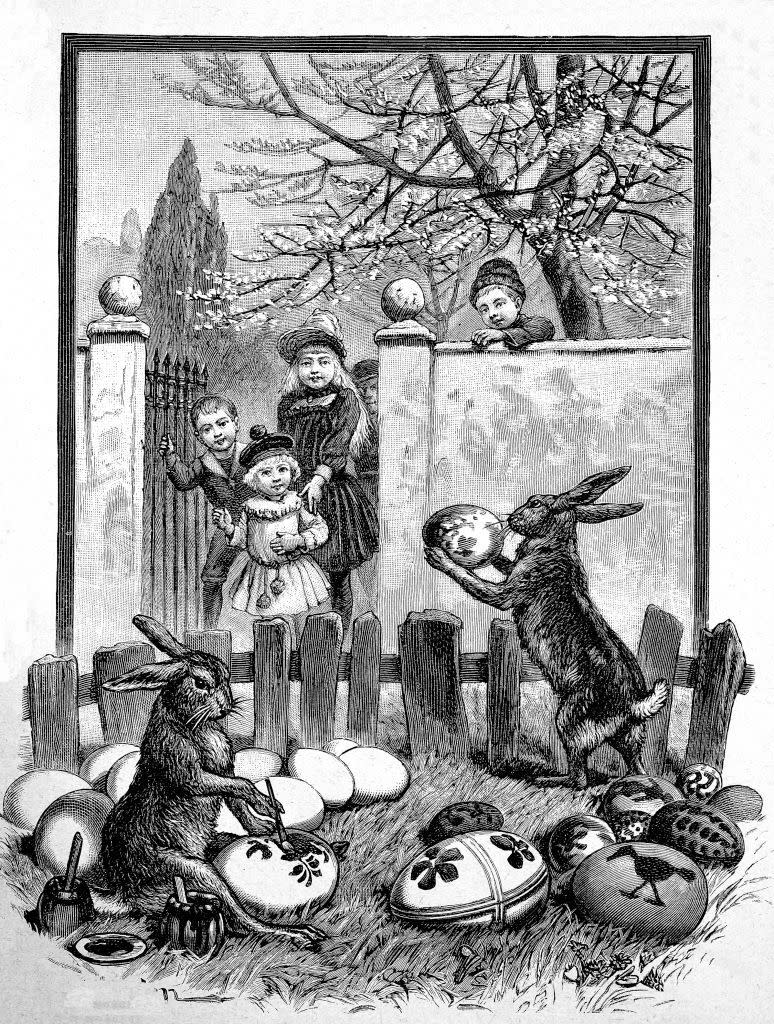The Easter Bunny's Origin Story Is Fascinating
When we think of Easter, it's hard not to immediately think of the Easter Bunny. But, though Easer is a Christian holiday, the Easter Bunny is never mentioned in the Bible. So how did Easter, a holiday that commemorates the resurrection of Jesus from the dead, become associated with a rabbit?
I decided to do a little digging—because if I'm going to eat oodles of chocolate and marshmallow treats modeled after the Easter Bunny each year, I should at least know why. It turns out, there isn't one clear-cut answer, but rather a few theories. Shall we hop to it?
The Goddess of Ostara/Eostre and the Easter Bunny
As it turns out, the Easter Bunny's origins appear to stem from German culture. Stephen Winick, a longtime writer at the Library of Congress's American Folklife Center, discusses the Easter Bunny's roots. In his article "Ostara and the Hare: Not Ancient, but Not As Modern As Some Skeptics Think," he lays out the narratives attached to the German goddess of spring Ostara (also known as Eostre).
While all the accounts present slightly different details, they all agree on one thing: There was a German goddess who transformed a bird into a rabbit. This rabbit had the unique ability to lay eggs. There was also something special about these eggs—they were colorful, like a rainbow. A festival was held each spring (the festival of Ostara/Eostre) that celebrated the goddess. On this day, the supernatural rabbit (possibly an ex-bird) would lay its colorful eggs for the children.
Winick touts the below explanation given in The Folk-lore Journal, Volume 1; Volume 11 as the most credible.
Originally the hare seems to have been a bird which the ancient Teutonic goddess Ostara (the Anglo-Saxon Eàstre or Eostre, as Bede calls her) transformed into a quadruped. For this reason the Hare, in grateful recollection of its former quality as bird and swift messenger of the Spring-Goddess, is able to lay eggs on her festival at Easter-time (r. Oberle’s Ueberreste germanischen Heidentums im Christentum, 8vo, Baden-Baden, 1883, p. 104.)
Inspired by the goddess's name, the festival of Ostara eventually was shortened to "Easter." This celebration and that resurrection of Christ eventually joined togetehr into one holiday of spring renewal and rebirth.
Oschter Haws and the Easter Bunny

While Ostara's story explains how the Easter Bunny tale originated in Europe, a more recent narrative explains how this story traveled to America. History.com writes of another German hare: This bunny was named Oschter Haws, and much like Ostara's hare, it had the ability to lay eggs of all different hues.
Oschter Haws came to America (and settled in Pennsylvania) with German immigrants in the 1700s. Children had heard that this rabbit could produce colored eggs and began building nests for him to deliver them. Oschter Haws did just that, making sure to follow the German tradition of delivering eggs on what was referred to as "Easter" back home. Eventually, Oschter Haws decided to branch out from PA and lay eggs for children all over the United States. He also upped the ante on his deliveries: he started bringing chocolates and other types of gifts to kids on Easter morning. Baskets soon came to replace nests and children started leaving carrots out for him the night before.
The Symbolism of the Easter Bunny and Jesus
So there you have it — history tells us that the Easter Bunny stems from a bird who became a rabbit that could produce eggs of all different hues. Although this story doesn't align with what's taught in the Bible, there are certainly similarities. While colored Easter eggs may not feel like a significant part of Jesus's story, eggs celebrate new life, the core of the Christian holiday. Happy Easter!
Follow House Beautiful on Instagram.
You Might Also Like

